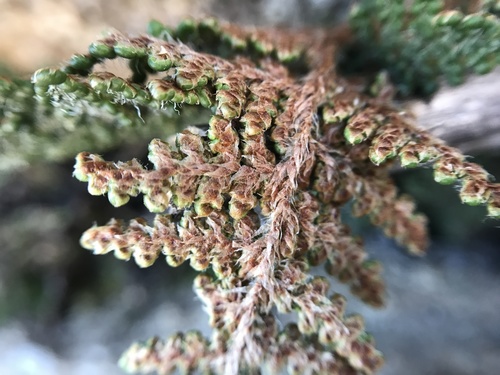Observations of the Month: Coville's and Cleveland's Lip Ferns (Pteridaceae)
Coville’s Lip Fern (Myriopteris covillei) https://www.inaturalist.org/observations/37466571 by @acorncap

Cleveland’s Lip Fern (Myriopteris clevelandii) https://www.inaturalist.org/observations/71342268 by @chloe_and_trevor 
Ferns are “primitive” plants. So you might think that you don’t need to take as many photos of a fern as you do of a flowering plant to capture important identifying characteristics. But that’s not usually the case. Ideally, when you create an observation for iNaturalist, you would take 4 or 5 photos of a fern, just as you would of a flowering plant. With no flowers or fruits to focus on, you may be wondering what parts of a fern you should photograph. Take a photo of the fern as a whole to show its habit (growth form and general appearance). A photo of the upper surface of a leaf (blade or frond) showing its overall shape and arrangement and shape of leaflets (segments) and presence or absence of hairs or other structures. A photo of the lower surface of a leaf to show the color of the lower surface (it’s helpful to have the upper surface of an adjacent leaf in the same photo to give contrast). A second photo of the lower surface as close-up as needed to clearly show the structures found there (e.g., sori, hairs, scales). Be sure to have a finger, ruler, or other object in at least one photo to show scale.
Coville’s Lip Fern and Cleveland’s Lip Fern look similar from a distance. With only one photo taken at a distance, it will likely be impossible to decide which of these species is represented. The location in our county can help since there is only a little overlap in the distributional range. Cleveland’s is found closer to the coast and inland up into the mountains where Coville’s is also found. Coville’s continues down the eastern slopes of the mountains and into some parts of our desert. Both species are often found growing in rocky areas. The upper surfaces of the fronds in both species are green and have no hairs although often the scales from the underside are readily visible on the upper side especially in Coville’s. Both have scales on the underside, but a close-up view of the scales will make all the difference in helping to determine which species it is. The scales on the underside of Coville’s are wider, obscure the surface, and exceed the margins. The scales on the underside of Cleveland’s are not as wide or as dense and are less likely to exceed the margins. By the way, if you look for the sori on the underside of a Myriopteris fern blade as I did and can’t find any, it’s because they are usually hidden under the recurved margins in this genus.
Taking multiple photos of ferns to show different characteristics will make it more likely that the species in your iNat observation can be determined. Visit the San Diego Plant Atlas website for resources to help you identify ferns and other plants.



